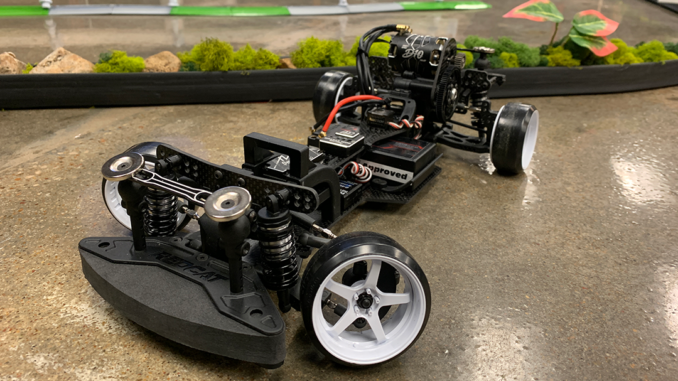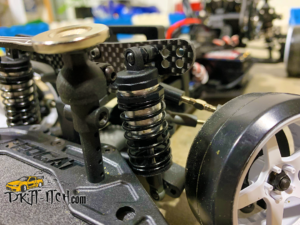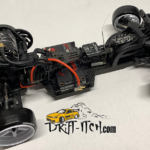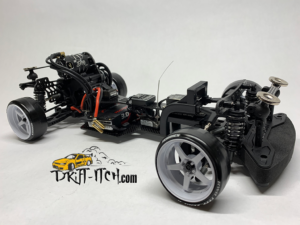
You know how sometimes you hear about something, but never register it as real until you lay your eyes on it? Like when I heard that Redcat Racing had put out another drift car, and that it was actually really good? Like a purpose-built drift machine packed with some of the latest features and even breaking new ground in some areas? It sounded too good to be true, but is it?
When the RDS RTR was first teased with that sort of you-like-it-or-you-don’t body, I just dismissed it, rolled my eyes and went on with my day. That is until I saw some body-off shots of it. Did I see some carbon fiber shock towers? A high or low motor mount setup, and a direct drive steering rack? A quick-adjust Ackermann setup?! When you look a little closer, it’s clear that Redcat have fielded something a lot more serious than before. This warrants a closer inspection.
-But first a few details…
Specs:
Manufacturer: Redcat Racing
Where to buy: Your local hobby shop or buy online at https://www.redcatracing.com/products/redcat-rds-builders-kit
Price: $239.99
Scale: 1/10th
Type: Electric rear wheel drive drift chassis (requires assembly)
Length: 445mm
Wheelbase: 253mm – 261mm Adjustable.
Suspension: 4 Coil Over Oil filled dampers.
Required to operate: Radio, battery, charger, servo, gyro, brushless motor, and electronic speed control.
When I heard Redcat was also doing a “Builders Kit” version, that was all it took, I had to get one for myself. I stopped by SlideworX RC (My local drift track; I love being able to say that!) and snatched one of these up. The thought of an American RC manufacturer competing in a space dominated by companies from the other side of the globe was big news; at least to me. I’ve been writing about RC drift for a long time and this is a very welcome change.
I had to do more than build and drive one of these though. I also reached out to RDS lead designer Shane Mikula from Redcat to shed some more light on how this product came to be.
You see Shane was already a hard-core drift addict when this project rolled around. Shane is also the owner of Tandem RC, a full-on drift track and pro shop based in Mesa Arizona. You don’t get much closer to having your finger on the pulse of the RC Drift scene than dealing with it day-in and day-out as a business. A huge asset for Redcat when moving into unknown territory. With the demise of AWD and the emergence of RWD drifting all over the world, it presented a rare opportunity when Redcat needed to fill a gap in its product line-up.
“I personally think RC Drift is one of the more challenging, yet most rewarding niches in the RC hobby.” – Shane Mikula lead designer on the RDS
A rare opportunity that Shane picked up and ran with. The RDS quickly became his passion project with a goal to make the RDS the best kit a beginner could buy and not have to immediately purchase a bunch of upgrades to make the car perform well. It comes box stock with alloy shocks, adjustable turnbuckles, a gear differential, carbon top and bottom plates. All stuff you don’t see on an entry-level kit. Then Redcat went a step further and added a bunch of competition-friendly features like a slop-free direct drive steering rack, quick-adjust Ackermann as mentioned above and quick access to the differential for easy tuning based on track condition. Throw in a multi-position high or low rear motor setup, easy to access suspension components, and you have a formidable contender right out of the box.
The Kit: In this article, I will be focusing on the kit version of the RDS. Plenty of other publications have given the RTR plenty of attention, but the kit version, (The version that appeals to me) has gotten almost none. This makes perfect sense since the RDS is meant to be an entry-level platform and the RTR is the obvious place to start for a beginner. But the RDS also comes packed with a bunch of features that appeal to a more experienced drifter as well, and frankly, I’m pleased they even decided to do a kit version at all. My perception in the past was that Redcat was a toy-grade RC manufacturer, but that has changed for good.
The Build: I mentally grade every kit I build whether I’m reviewing them or not. Putting a kit together and making the parts bags flow with the manual as to not overwhelm the builder with too many parts, too much hardware and general chaos of the bench during the build process is an art form in my opinion. It is also a quality that a lot of people take for granted. I do not. I appreciate when a manufacturer has taken the time to make sure the construction of a kit goes smoothly. If you have ever built a kit where this is not a concern you know what I am talking about. You spend more time looking for parts and hardware than you do enjoying a build.
No problems like that with the RDS. I’m pleased to say that Redcat have delivered a very enjoyable kit to build. The build was fast and neat with very few hitches. The only things I can nitpick are I wish the manual had part descriptions along with part number and dimensions. The diagrams are not the most detailed and it can be hard to tell the difference at a glance between a washer and an o-ring.
Kit Quality: I’ve built dozens of kits over the years from the biggest names in RC to the most obscure. The RDS feels like it’s built from high-quality materials. Part fitment is good and no hand fitting is required though the plastics lean toward the soft side. It can be a fine line to get just the right mix of flex vs rigidity. Given that the box states that it is made of “high-impact plastic” it’s clear to me this was a conscious choice. Softer plastics tend to bend instead of break, but you lose some structural rigidity as a result. Most high-end drifters are much more stiffly built and only flex in places the manufacturer intends to. This might be Redcat sort of hanging on to their basher roots, or maybe it’s just a manufacturing limitation with the injection molding. Either way, it’s not something you generally see on a competition-level kit, so expect this chassis and suspension to have some give. This being their first entry into this space I’m willing to not let it overshadow my opinion of the kit overall because it all seems to work well together. No stripped screws or anything like that so no real complaints there, just an observation.
The real star of the show here is all of that beautiful carbon fiber. The box would let you on to thinking that the RDS has gold threaded into the weave, but when you pull it out of the box you can see it’s pretty much standard carbon fiber. I was a little let down by this, but the car still looks really good. The machining on the carbon is top-notch, with no snags, or distortions in the weave. The chassis is designed with a narrow channel in it to allow for longitudinal flex, but extremely rigid nose to tail thanks to the carbon top deck. The RDS also boasts full carbon shock towers and motor-plate. I’m hoping an aluminum heatsink motor plate is in the works because I’m not sure about the use of carbon here. Other nice touches are the channels milled into the lower plate to accommodate wiring to go under the battery if you choose to mount your ESC aft. This helps clean up the wiring and goes a long way toward a tidy-looking build.
I do have one minor complaint with the materials in this kit, and that is the ball cups. This is a subject I have heard many complain about online and I have to agree. They seem to be way too soft and the plastic is a little too “grippy”. That being said I did pop the ball cups off of the steering rack several times while tinkering and they still seem to work OK. I would just be careful with them. I am hoping they will “wear-in” and loosen up over time. While this is a little annoying, it is not a show-stopper. I’ve seen much worse binding on other chassis.
Durability: I did not experience any durability issues with the RDS during testing. Some RTR owners at the track did though. The main culprit is the direct drive steering rack. The single bellcrank/servo horn is directly attached to the steering linkage. While this is very responsive and slop free, takes the full brunt of any impact the front wheels incur. All of that stress is focused right on the servo spline causing the stock plastic horn to strip out on a heavy hit. For that reason, I recommend the upgraded aluminum servo horn available from Redcat (part number RER19685). This design is used on a few really high-end competition cars so I applaud the design choice, it’s just the choice of materials used that makes it problematic. Like I said I didn’t have any issues but I mostly keep my car off of the boards. I still upgraded mine the first time I had the front end of the car apart just for good measure.
recommend the upgraded aluminum servo horn available from Redcat (part number RER19685). This design is used on a few really high-end competition cars so I applaud the design choice, it’s just the choice of materials used that makes it problematic. Like I said I didn’t have any issues but I mostly keep my car off of the boards. I still upgraded mine the first time I had the front end of the car apart just for good measure.
Upgrades: At the time of writing, there aren’t any upgrades available for this car from Redcat other than the aforementioned aluminum servo horn. I have it on good authority that many aluminum goodies are in the pipeline and we should start to see some start to hit the market soon. That being said drifters are inherently mad scientists when it comes to building cars and people are already going nuts with experimenting with this car. Many upgrades designed for other chassis seem to work just fine on this car so there are plenty of options out there if you are creative. That being said I’m excited to see the factory options start to roll out.
Performance: While I may not be a seasoned comp guy who can judge how the car works in the heat of battle, I can judge how well the car works from a general handling point of view. I opted not to run the kit tires and wheels and instead went to the spec tire preference we run at SlideworX. I’ve seen some of the RTR RDS run on the stock wheels and tires and they seem OK, but I really sort of question why they were included in the kit version of the car at all. I would have rather seen them omitted and the car’s price dropped by 5-10 dollars, or maybe offset some of the cost by including the aluminum servo horn in the box. But that’s neither here nor there so let’s move on.
I set the car up like my personal cars with the motor in the highest rearward position with most of the electronics midship. I put the ESC right under the motor as per my normal setup. With no additional weight added this put the weight bias at about 38% front to 62% rear. This car is exceptionally light so that leaves lots of room to play with weight bias to tune to your personal preference.
I threw the car down on the track using the box stock suspension setup settings and took it out and drove it. I was very comfortable with it right off the bat. It didn’t feel altogether different than my other cars and certainly did not exhibit any ill-handling characteristics.
That does not mean there is no room for improvement. After several packs the springs were breaking in and needed adjustment regularly. I quickly went away from the initial shock setup and added a rearward rake to the stance to force some more weight bias to the rear. I tweaked the rear camber to accommodate for the track’s glossy surface and it was even better. Adding some more weight could further dial this car in but we are testing what we have in the box, so I would say in stock trim the car works pretty well.
My only performance complaints are in the steering throw department. At full lock your leading wheel just never quite gets out there where I would like. The steering stops on the stock knuckles cut it just short of where it should be. People are already modding their cars to address this, and I plan on doing some tinkering here to see if I can get more out of it.
In a nutshell:
Likes: Price, good quality, good performance right out of the box, very few required upgrades. Tinker’s playground. Tons of potential with this chassis. Parts availability of a stateside manufacturer should not be understated and should play into any buyer’s consideration when choosing a chassis.
Dislikes: It’s kind of wide. Having the option to run a more narrow wheel offset and body would be great. The rear hub carriers prevent this. Hoping for a revised front steering knuckle as well to increase the steering angle.
Final thoughts:
There is no doubt that the RDS is an impressive performer at this price point. I’ve watched it hold its own against setups that were 4 times the cost. In the right hands, this car ranks well in competition. You are slowly seeing Redcat’s name showing up among the more prestigious brands in large competition results. Even so, for some reason, this car seems to get a lot of hate which I don’t understand. Maybe it’s because Redcat is new to this space, or people are just afraid of someone shaking things up. Maybe it’s because this 240 dollar car has the potential to hang with cars that cost several times more. Whatever the reason don’t agree. I was never a Redcat fan, but I am now. I love the passion that went into this car and that an American brand has joined the ranks of manufacturers that support our hobby. Redcat has a winner on their hands I can’t wait to see where we go from here.
That’s it for now gang, I appreciate you stopping by for another edition of Drift Itch. If you would jump out to my Facebook page (you can find it at the top right of the page) and give me a like to help grow the page. Thanks for your support, and I’ll catch you on the next one!
-Evol
Want to see some video of this thing in action? Check it out on my youtube channel here!
Want to pick one of these up for yourself. Youcan grab one of these right now from Redcat here.








